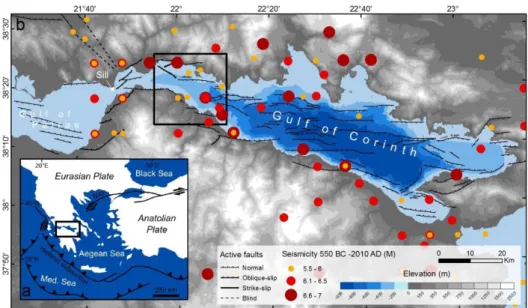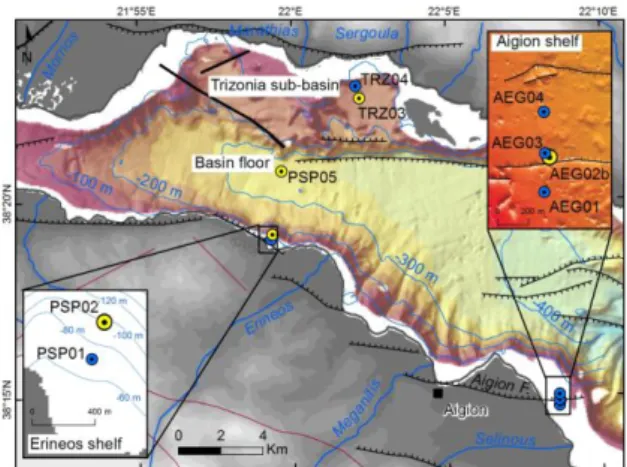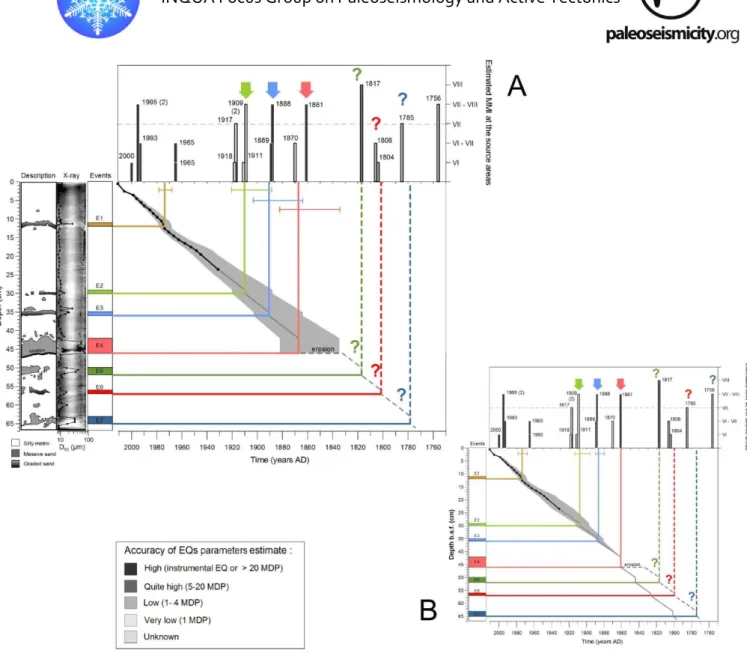6th International INQUA Meeting on Paleoseismology, Active Tectonics and Archaeoseismology, 19-24 April 2015, Pescina, Fucino Basin, Italy
INQUA Focus Group on Paleoseismology and Active Tectonics
Sedimentary impacts of recent moderate earthquakes in different settings in the Western Gulf of
Corinth, Greece
Beckers, A. (1,2), Mortier, C. (1), Beck C. (2), Hubert-Ferrari, A. (1), Reyss, J.-L. (3), Albini, P. (4), Develle, A.-L. (5), Tripsanas, E. (6), Sakellariou, D. (6), Crouzet, C. (2), Rovida, A. (4) and Scotti, O. (7)
(1) Dept of Geography, University of Liège, allée du 6 août 2, 4000 Liège, Belgium. Email : abeckers@ulg.ac.be. (2) ISTerre, CNRS UMR 5275, University of Savoie, F-73376 Le Bourget du Lac, France.
(3) LSCE, CNRS UMR 8212, avenue de la Terrasse, 91198, F-91191 Gif-sur-Yvette, France (4) Istituto Nazionale di Geofisica e Vulcanologia, Via E. Bassini, 15, 20133 Milano, Italy (5) EDYTEM, University of Savoie/CNRS, Le Bourget du Lac, France
(6) Institute of Oceanography, Hellenic Center for Marine Research, GR-19013 Anavyssos, Greece (7) Institut de Radioprotection et de Sûreté Nucléaire (IRSN), Fontenay-aux-Roses, France
Abstract: 11 short gravity cores retrieved in the Western Gulf of Corinth, Greece, allowed identifying event deposits whose age
ranges were compared to an updated earthquakes catalogue for the area. 210Pb-derived age-depth curves show that the majority
of the event deposits may have been triggered by earthquakes. These results show that moderate earthquakes (Mw ~6.0-6.5) may
significantly impact different marine settings, from shallow shelves (70-100 m deep) to the basin floor (330 m deep). The deepest coring sites show the best possible record, but one major earthquake is missing and the age of one event deposit does not fit with any known earthquake. More cores are needed to check the spatial extent of each deposit and to validate the absence of record of some earthquakes, like the 1995 Aigion earthquake.
Key words: paleoseismology, marine sediments, event deposits, sediment density flows, turbidite.
INTRODUCTION
Marine or lacustrine paleoseismology has several advantages in comparison with onland methods: higher potential for preservation, possible long-term record, and better spatial coverage (Goldfinger, 2009). However, most of the sedimentary processes that are considered as potential offshore indicators of earthquake (EQ) shaking (submarine landslides, turbidity currents, tsunami
backwash flows) can also be triggered without any EQ. Many works have been achieved to try to discriminate earthquake-triggered from non-earthquake-triggered offshore event deposits (e. g. Adams, 1990; Shiki et al., 2000), but the existence of diagnostic criterion is still debated (Talling, 2014).
The aim of this communication is to analyze in detail the influence of moderate EQ shaking on the sedimentation
Fig. 1: Physiography, active faults, and historical seismicity (550 BC – 2010 AD, M≥5.5) in the area of the Gulfs of Patras and Corinth The black box in (b) shows the study area. Location in inset a. Historical earthquakes from Papazachos et al. (2000, 2010). Active faults in the Corinth rift and in the Gulf of Patras from Beckers et al. (2015) and references therein. Bathymetry adapted from Bell et al. (2009), elevation from SRTM (http:// http://srtm.usgs.gov/).
6th International INQUA Meeting on Paleoseismology, Active Tectonics and Archaeoseismology, 19-24 April 2015, Pescina, Fucino Basin, Italy
INQUA Focus Group on Paleoseismology and Active Tectonics
in different marine settings, from shelves to basin floor, in order to identify which environment may provide the more complete and the less noisy EQs record.
STUDY AREA
The study area is the Gulf of Corinth, Greece. It is a 120 km long, 869 m deep depression located in central Greece (Fig. 1). This basin is connected to the Mediterranean Sea at its western tip through a 62 m deep, 2 km wide sill. Numerous damaging EQs are known in Gulf of Corinth region for at least 2000 years by historical sources (Fig. 1), with largest estimated magnitudes approaching 7 (Ambraseys & Jackson, 1997). In the western part of the Gulf, that is investigated in the present study, tsunamis and submarine landslides have been triggered by historical EQs (Schmidt, 1887; Papatheodorou & Ferentinos, 1997), but these phenomena also happened without any EQ (Heezen et al., 1966). Only one study has been dedicated to the identification of offshore historical (before 1990) earthquake-related deposits in this area (Lykousis et al., 2007). These authors investigated the basin floor of the Western Gulf with short box cores and identified a widespread 6-10 cm thick sandy deposit attributed to the 1861 earthquake. This result highlights the potential of this area for developing offshore paleoseismological methods.
METHODS
The method developed here consists in crossing estimated macroseismic intensity data series with age-estimated event deposits identified in short gravity cores. The aim is to check the completeness of the sedimentary records of EQs in different settings of the Western Gulf. An in-depth analysis of existing and newly found historical sources has been done to build an updated catalogue of past EQs in the Western Corinth Rift area, from ~1400 AD to today. 9 short gravity cores (40-85 cm long) have been retrieved in four different sites (Fig. 2) : the Aigion Shelf (~40 m deep), the Erineos Shelf (70-100 m deep); the Trizonia sub-basin (~180 m deep), and the basin floor (330 m deep). X-radiography, magnetic susceptibility, core-scanner X-ray fluorescence (XRF) measurements and high-resolution (2 mm) grain-size measurements have been carried out to highlight and characterize specific layers possibly deposited during or shortly after earthquakes, such as turbidites and tsunami back-wash flow deposits. The age control is based on
unsupported 210Pb and 137Cs activity profiles measured on
4 cores. The average last-century sedimentation rates have been applied to the hemipelagic intervals downcore to estimate the age of deeper layers. The use of the event deposit associated to the largest EQ as an anchor point in the age-depth curve is tested. Finally, a source area has been defined for each coring site as the offshore and
coastal areas where sediment failures could have occurred and could have triggered sediment-density flows recorded at this coring site. Based on the Papazachos and Papaioanou (1997)’s attenuation model for Greece and our updated EQ catalogue, intensity (Modified Mercalli Intensity scale, MMI) has been estimated for each EQ in each source area.
RESULTS AND INTERPRETATION
The first coring site is in the Aigion Shelf, a ~40 m deep shelf crossed by the Aigion fault and characterized by a field of pockmarks and sand volcanoes (Fig. 2). The 4 cores (AEG01 to 04) are visually homogenous and composed of grey-brown silt. 3 coarse-grained layers have been highlighted by the grain-size analysis and
some XRF ratios. 210Pb and 137Cs activity profiles are very
irregular and do not allow to derive valuable age control. The Erineos Shelf is a small shelf located west of the homonimous delta (Fig. 2). Two cores (PSP01 and 02) have been retrieved at -70 m (62 cm long) and -100 m (85 cm long). Four coarse-grained layers have been identified in the longest core, and two of them can be correlated with the 2 events observed in the shortest core. Events are 2-5 cm thick and are made of sandy silt, the sandy fraction being composed of plants remains and of a few terrigenous grains. Accurate age-depth curve shows that events could have been triggered by 2 EQs (i.e. in 1817 and 1861). However, the number of EQs with MMI ≥VII is larger than the number of event deposits identified in the cores during the 260-300-year sampled period.
Fig. 2: Location of the coring sites. Circles indicate cores location; yellow circles indicate cores where 210Pb and 137Cs activity profiles have been measured. Bathymetry from Hellenic Center for Marine Reasearch (unpublished data) and from Cotterill (2006). Active normal faults (black lines, bold indicates a strike-slip component) from Beckers et al. (2015) and references therein.
6th International INQUA Meeting on Paleoseismology, Active Tectonics and Archaeoseismology, 19-24 April 2015, Pescina, Fucino Basin, Italy
INQUA Focus Group on Paleoseismology and Active Tectonics
Two cores (60 and 70 cm long) have been retrieved in the 180 m deep Trizonia Sub-basin (Fig. 2). The cores both contain 5 event deposits. They consist of thin bioturbated sandy layers, some of them having been only detected by high-resolution grain-size analyses or X-radiography. Correlation between the cores is difficult because of the absence of anchor points in the hemipelagic intervals and because of the bioturbation. Age-depth curve for TRZ03 shows that 5 event deposits in this core fit reasonably well with the 5-7 EQs of MMI ≥ VII. However, the last major EQ, the 1995 Aigion EQ, seems to be not recorded despite a local estimated MMI between VII and VIII. In addition, an event occurred between 1930 and 1950, a period without any significant EQ in this area.
The last site is in the basin floor, at 330 m below sea level (Fig. 2). The 65 cm long core retrieved there contains 7
sandy layers (Fig. 3). These event deposits are 1-4 cm thick and XRF data show that they are made of terrigenous grains. The deposits are normally graded (turbidites) or massive. Age-depth curve shows that the thickest event, E4, very likely corresponds to the 1861 EQ (Fig. 3). As in the Trizonia Sub-basin, the number of event deposits reasonably matches the number of MMI ≥ VII EQs. Using E4 as an anchor point reduces the age uncertainty for E1, E2 and E3, and reinforces the interpretation that E2 and E3 have been triggered by the 1909 and 1888 EQ (Fig. 3). However, similarly to the Trizonia Sub-basin, the 1995 Aigion EQ is missing and one event (E1) probably does not fit with any known EQ.
Fig. 3: Example of analysis carried out for the core PSP05 (basin floor). A) to the left, core description, X-radiography, grain-size profile and event deposits; to the top, macroseismic intensities (MMI: Modified Mercalli Intensity scale) estimated for historical earthquakes; in the center, 210
Pb-based age-depth curve. B) same core but age-depth curve built using the likely 1861 earthquake deposit as an anchor point. Colored arrows highlight earthquakes that have probably impacted the sedimentation. Bottom left: accuracy of earthquakes parameters estímate (magnitude and location) based on available data (MDP: macroseismic intensity data point(s)).
6th International INQUA Meeting on Paleoseismology, Active Tectonics and Archaeoseismology, 19-24 April 2015, Pescina, Fucino Basin, Italy
INQUA Focus Group on Paleoseismology and Active Tectonics
DISCUSSION
Our results allow discussing the interest of different marine settings for paleoseismology. The Aigion shelf appears as not appropriate because of the low contrast between possible event deposits and the background sedimentation, and the difficulty to establish an age-depth curve. The event-deposits record is clearer in the Erineos Shelf, but the two retrieved cores did not allow to find a complete record of MMI ≥ VII EQs. Either some of these EQs did not trigger any sediment density flow, or the associated deposits do not have a wide spatial extent or have been eroded. Shelf environments are
characterized by a discontinuous sedimentation
influenced by river floods and oceanic processes (Addington et al., 2007; Knikskern et al., 2009). When marine currents are present, erosion may occur frequently (Carlin & Dellapenna, 2014). Shelves consequently may not be the more suitable setting for off-fault paleoseismology. In deeper settings (Trizonia sub-basin and basin floor), the record seems more complete, and age-depth curves are easiest to establish. The deepest site appears to show the best record in terms of event thickness, age-depth curve, and completeness of the possible EQ records. However, based on one core, the event-deposits record does not fit perfectly with the MMI ≥ VII EQs series. More cores are needed to check the spatial extent of each deposit and to validate the absence of records for some EQs, like the 1995 Aigion EQ.
We tried to use the event deposits associated with a remarkable event (the 1861 EQ, M≈6.5) as an anchor point to improve the age-depth curves. The risk was to fall into a circular reasoning. However, this earthquake induced an estimated MMI ≥ VII in the source area of each coring site, and an event deposit has been observed in each core at a depth that could correspond to the age of this earthquake. Consequently, this hypothesis may be considered as reasonable. Fig. 3 shows that including this anchor point does not improve the possible association between event deposits and earthquakes for the period before 1861. This may be due to a change in the sedimentation rate, which is difficult to constrain for this time period. However, for the sediments deposited after 1861 in PSP05, the improved age-depth curve allows to reduce the age uncertainty for 3 events, showing that 2 of them accurately fit with two earthquakes.
CONCLUSION
A detailed sediment cores analysis associated with the development of a new, updated, earthquake catalogue shows that moderate EQs probably significantly impact different marine settings at the Western tip of the Gulf of Corinth. The event deposits record however does not perfectly match the MMI ≥ VII earthquake historical record. More work is needed to improve the spatial coverage of coring sites in order to check this mismatch.
References
Adams, J., (1990). Paleoseismicity of the Cascadia subduction zone—Evidence from turbidites off the Oregon-Washington margin, Tectonics. 9, 569–583.
Addington, L.D., Kuehl, S.A., McNinch, J.E., (2007). Contrasting modes of shelf sediment dispersal off a high-yield river: Waiapu River, New Zealand. Marine Geology. 243, 18-30. Ambraseys, N.N., Jackson, J.A., (1997). Seismicity and strain in
the Gulf Of Corinth (Greece) since 1694. Journal of Earthquake Engineering. 1,433-474.
Beckers, A., Hubert-Ferrari, A., Beck, C., Bodeux, S., Tripsanas, E., Sakellariou, D., De Batist, M., (2015). Active faulting at the western tip of the Gulf of Corinth, Greece, from high-resolution seismic data. Marine Geology. 360,55-69. Bell, R. E., McNeill, L. C., Bull, J. M., Henstock, T. J., Collier, R. E.
L., Leeder, M. R., (2009). Fault architecture, basin structure and evolution of the Gulf of Corinth Rift, central Greece. Basin Research. 21, 824–855.
Carlin, J.A., Dellapenna, T.M., (2014). Event-driven deltaic sedimentation on a low-gradient, low-energy shelf: The Brazos River subaqueous delta, northwestern Gulf of Mexico. Marine Geology. 353, 21-30.
Cotterill, C. J., (2006). A High-resolution Holocene Fault Activity History of the Aigion Shelf, Gulf of Corinth, Greece. PhD Thesis, University of Southampton.
Goldfinger, C., (2009). Sub-Aqueous Paleoseismology. In Paleoseismology (Mcalpin, J., ed.). Elsevier, 119-169. Heezen, B. C., Ewing, M., Johnson, G. L., (1966). The Gulf of
Corinth floor. Deep-Sea research. 13, 381–411.
Kniskern, T.A., Kuehl, S.A., Harris, C.K., Carter, L., (2009). Sediment accumulation patterns and fine-scale strata formation on the Waiapu River shelf, New Zealand. Marine Geology. 270, 188-201.
Lykousis, V., Sakellariou, D., Rousakis, G., Alexandri, S., Kaberi, H., Nomikou, P., Georgiou, P., Balas, P., (2007). Sediment Failure Processes In Active Grabens: The Western Gulf Of Corinth (Greece). In : Submarine Mass Movements and Their Consequences (Lykousis, V., Sakellariou, D., Locat, J., eds.). Springer, Advances in Natural and Technological Hazards Research. 27, 297 - 305.
Papatheodorou, G., Ferentinos, G., (1997). Submarine and coastal sediment failure triggered by the 1995, Ms = 6.1 R
Aegion earthquake, Gulf of Corinth, Greece. Marine Geology. 137, 287-304.
Papazachos, B. C., Comninakis, P.E., Scordilis, E. M., Karakaisis, G. F., Papazachos, C. B., (2010). A catalogue of earthquakes in the Mediterranean and surrounding area for the period 1901 – 2010. Publ, Geophys, Laboratory, University of Thessaloniki.
Papazachos, B. C., Comninakis, P. E., Karakaisis, G. F., Karakostas, B. G., Papaioannou, Ch. A., Papazachos, C. B., Scordilis, E.M., (2000). A catalogue of earthquakes in Greece and surrounding area for the period 550BC-1999. Publ, Geophys, Laboratory, University of Thessaloniki. 1, 333 pp. Papazachos, C., Papaioannou, C., (1997). The macroseismic field
of the Balkan area. Journal of seismology.1, 181-201. Schmidt, J., (1887). Studien iiber Erdbeben. Leipzig.
Shiki, T., Kumon, F., Inouchi, Y., Kontani, Y., Sakamoto, T., Tateishi, M., Matsubara, H., Fukuyama, K., (2000). Sedimentary features of the seismo-turbidites, Lake Biwa, Japan. Sedimentary Geology. 135, 37-50.
Talling, P. J., (2014). On the triggers, resulting flow types and frequencies of subaqueous sediment density flows in different settings. Marine Geology. 352, 155-182.


